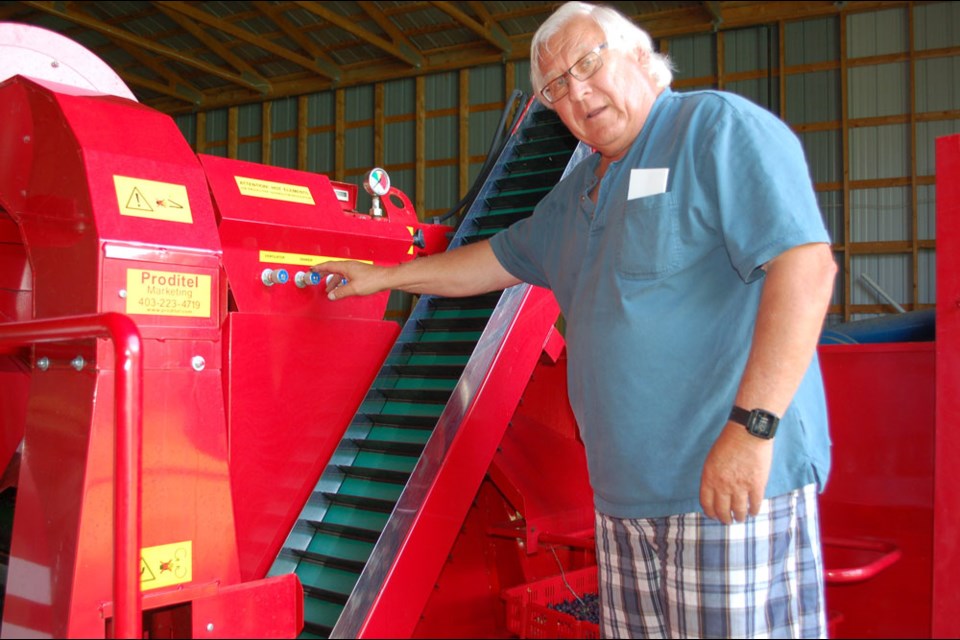It was a small but significant farm, but, as Sally Ciepliski puts it, “who can make a go of farming these days with just two quarter sections?”
So the brainstorming wheels got into action, and it wasn’t too long before this extended family determined that specializing in this province’s signature fruit, the Saskatoon berry, could be the answer.
So in 2000, five acres of the land that has been in the Ciepliski name for over 90 years, was turned into an orchard, and three years later, it was doubled in size, even before the first bushes had matured enough to produce any berries.
No regrets.
This year’s harvest of the priceless prairie berry came in at over 11,000 pounds during a relatively short harvest season of just over two weeks. There were another 2,000 lbs. left on the bushes for hand-picking by the “U-pick” visitors to the orchard and another 800 lbs. were shipped to a Moose Jaw area marketer for use in the juicing process. That juicing and cleaning service is provided by Judy and Ken Purdy, who were once featured on the popular CBC television show, Dragon’s Den.
“We tried to keep on farming traditional crops for a few years after planting the orchard, but decided it was best to lease the rest of the land out because the orchard was taking up a lot of our time,” said son Aaron, who is an integral part of the management team with his wife Melanie. “My sister Stephanie (Helmarson) and her family who live in Winnipeg are here a lot. They help with harvest, as does my brother Dustin, from Calgary, and his family. So it’s a big family situation and, of course we have our arguments, how else can you let your family know you love ‘em,” he said with a laugh.
The arguments are never serious and the togetherness seems to work, even to the point that all members of the extended family have lots of space to work, cook and sleep in a large house Aaron built in the yard a few metres from the orchard entrance.
“Otherwise, they were tenting on the lawn and we were living in a mobile home. So now everyone has a place in a great big house,” he said.
A nearby shop houses a busy berry cleaning and sorting operation while the back portion is where you’ll find the harvesting and maintenance equipment.
The farm also features a few rescued dogs, whose numbers fluctuate depending on how many family members are there at any time.
“My brother and sister’s kids like to come here. In fact, a few of them are old enough to drive now, and they make their way here for a lot of weekends, on their own,” said Aaron.
The operation also features a herd of 40 alpacas, whose wool is woven into comfortable, wearable products that the family sells on the farmers’ market circuit they frequent during the spring, summer and fall seasons, which includes Estevan, Weyburn, Kenosee, Oxbow and Carnduff.
The family also sells a number of bakery products straight from their farm’s industrial-sized kitchen with most of the products featuring the Saskatoon berries in jams, jellies, pies and buns.
“We have the 10 acres in Saskatoon bushes, and in 2025 we’ll have the centennial celebration of our family’s ownership of this farm,” said Sally.
There had once been a Saskatoon co-operative marketing board, but that is no longer. Aaron said it served a strong purpose since it marketed their products to a range of provincial co-operative stores bearing the Saskatoon berry labels for jams and jellies as well as frozen berries.
In the future, the team might expand to put a few more acres into sour cherries and/or raspberries since those are two items that could be easily harvested with the existing equipment.
Basil Ciepliski said the family purchased the mechanical harvester out of necessity in 2008 as the berry bushes really began to flourish after a few struggling years. There have been setbacks too, with hail and wind damage, which sometimes destroyed an entire crop.
A few days after the “blossoms drop” the berries emerge and within weeks the harvest can begin. The blossoms usually begin to drop around Mother’s Day, said Aaron.
“I suppose we might be able to harvest blueberries or highbush cranberries,” too said Basil, indicating that the family is always seeking new adventures in agriculture.
Proditel is the name behind the harvest machinery “with a lot of Scandinavian input in it,” said Basil who said they purchased theirs from a Taber, Alta., producer. The only crop protection they have required is an application of fungicide early in the season, which also requires a special configuration to ensure the product gets into the bush.
The farm, turned orchard, was purchased by Basil’s father Steve who arrived from Europe and took possession of the farm and later married a local girl. Steve and Ann started their family and then he served in the Second World War as an army mechanic, returning after war’s end to keep working on the traditional farm operation. No doubt he would be proud of the way things turned out.
A small and significant part of that farm is now an orchard where the Ciepliski family gathers often in the well-groomed yard, orchard or sprawling home where they get to eat, sleep, laugh and yes … argue on occasion, about things that matter to them, which probably means a lot of talk about saskatoons, alpacas and typical family issues.



